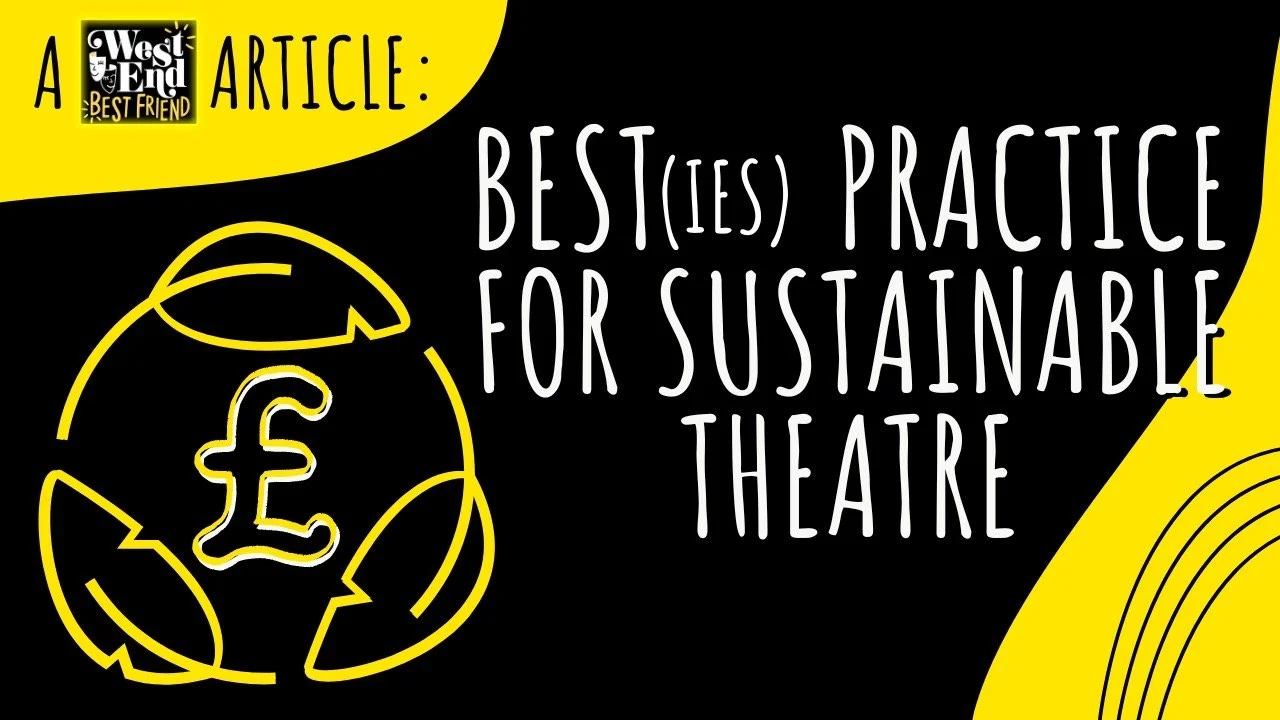A WEBF article: BEST(IES) PRACTICE FOR SUSTAINABLE THEATRE
Besties, it’s no secret that we love live theatre. The creativity, the shared experience, the storytelling and emotional connection to characters and themes makes visiting a theatre a unique enjoyable and moving experience. There is nothing else like it and we know that many more would discover this joy if they can be tempted to book. Yet for all that, it is also a business and one that needs to deliver a return to its funders, be they philanthropic Angels, Local Authority subsidisers, The Arts Council, or investors taking a speculative risky punt. There is a balance between rewarding those in the creative process, those providing the upfront cash and those buying the tickets, which is a delicate ecology that the producers and venue operators find themselves at the centre of.
The Covid pandemic put this ecology under great strain, and it is a great credit to all in the industry that it has emerged in such a robust state for the time being. The Government Furlough scheme, the HMRC Freelance support and organisation’s own reserves were critical, and the Coronavirus Business Interruption Loan scheme (CBILS) bridged some of the funding gap. The enhanced Theatre Tax Relief (TTR) of 45% & 40% (currently 50% & 45%) which equates at 80% recovery to 36% for touring & 32% for non-touring (currently 40% & 36%) has been critical in getting productions mounted since Theatres reopened. However, the pandemic has left the Government, Local Authorities, and producers and venues finances more stretched and while hit shows are attracting full houses and higher average ticket prices (ATP), some sections of the audience have not returned in the same numbers as pre-pandemic and new works are riskier than ever.
It is an important sector of the economy with a SOLT/UK Theatre survey indicated that there were over 1600 venues in UK, over 200,000 workers, over 30 million tickets sold and in total, generating nearly £4.5 billion of turnover (roughly a third from ticket sales and rest from hospitality and other activity linked to a visit). In the West End, there have been recent positive signs with more performance in 2022 than in 2019, more tickets sold, ATP reaching £64 in 2023 (£54 in 2019) but in real terms, SOLT estimates turnover was down by 1% in 2022.
In planning for the future, businesses must look ahead at the market conditions and often identify what they call headwinds, challenges that hinder growth or progress. To continue the sailing analogy, as we look forward, there would appear to be some stormy seas ahead which producers will need to carefully navigate and sailing headfirst into them may mean some are sunk and the smarter ones will need to tack around them to find calmer waters.
The current government has clearly recognised these challenges recently by announcing that the current levels of TTR will remain permanently at the current raised level. This will significantly assist producers trying to raise finance for their productions as the risk of failing to recoup is significantly reduced by this level of support. It is hoped that the next government maintains this level of commitment to theatre and that this will support the development of new works.
Rising costs are changing the risk profile of staging productions, and whether the recent huge increase in utilities costs or the impact of consecutive 10% rises in minimum wages (now £11.44 for an over 21-year-old compared to £8.36 in 2021), these increases affect many elements of the cost base. As a result, capitalisations required to mount productions, and weekly running costs have risen sharply post pandemic. Despite TTR and higher ticket prices, the required capacity to recoup has risen for many from around 60% to over 70% adding significantly to the risks for producers and their financiers.
Overlay on this the economic pressures on regional theatres from local authorities cutting or eliminating subsidy for the non-statutory provision of live theatre in their boroughs, or worse still, an estimated 20% of local authorities expected to declare technical bankruptcy, and it feels inevitable that many more venues will close their doors or cut back their programmes. This deprives those local communities of the live experience with its benefits for social cohesion and mental health. It makes touring the UK more challenging if there are geographic gaps in the theatre provision.
Many of our largest players in the sector who manage venues and are key funders in productions such as companies like ATG, Crossroads or TEG are supported by Private Equity investors. They provided support during Covid when these large organisations needed it but continue to expect year on year growth in EBITDA (Earnings Before Interest Depreciation and Amortisation) against this background. It is natural that they will respond by being more risk averse to undertake new work and reluctant to invest more cash.
Many other funders do not require a financial return but seek to support live theatre for its other social and cultural benefits. The escalating ticket prices as a response to the economic pressures inevitably limit audiences’ frequency of visits or how much they will pay, especially for a new work or a production without star names. Furthermore, it is hugely divisive, making live theatre a more elitist experience for those who can afford the prices and inaccessible to young people or new theatregoers. Dynamic pricing is reaping the benefits for producers from successful shows nearing sell out but acts against those younger buyers who traditionally book late.
Indeed, those 16-to25-year-olds, a generation of Screenagers, more comfortable communicating through a device than face to face, are in danger of forming the habit of seeing their drama and storytelling on a streaming platform rather than in a live theatre. Their GCSE and A level English Literature visits to the theatre may not be enough to tempt them to pay the higher prices.
To further complicate the challenge of attracting audiences, the worthy desire in the industry to see more inclusivity and diversity in the stories, casting and audiences requires more risk taking as such projects targeting in content or casting to be more inclusive and diverse, may not initially attract the required audiences to recoup or find performers with sufficient experience to carry the show.
Equally, the global challenges of climate change and the need to adopt more eco-friendly practices will require investment in new equipment, changes in practices, and procurement and support to change audiences travel arrangements. A carbon neutral industry will require innovation, rapid change, and cash.
So how are producers and venues tackling these headwinds to steer the sector through these stormy waters? Over the coming weeks, West End Best Friend intends to examine these issues in more depth and develop a Besties Manifesto for the theatre to build on the success of lobbying that secured the TTR permanency at the higher rates. We believe that gathering together best practices and making the case as to why the financial support to the sector is so crucial can contribute to steering the sector through these challenges and support the health of the nation.
Nick Wayne
March 2024

